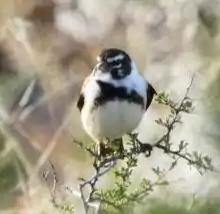| Damara canary | |
|---|---|
 | |
| Male | |
| Scientific classification | |
| Domain: | Eukaryota |
| Kingdom: | Animalia |
| Phylum: | Chordata |
| Class: | Aves |
| Order: | Passeriformes |
| Family: | Fringillidae |
| Subfamily: | Carduelinae |
| Genus: | Serinus |
| Species: | |
| Subspecies: | S. a. leucolaema |
| Trinomial name | |
| Serinus alario leucolaema (Sharpe, 1903) | |
The Damara canary (Serinus alario leucolaema) is a small passerine bird in the finch family.
Taxonomy
The taxonomic status of this bird is uncertain. It is listed by the International Ornithologists' Union as a subspecies of the black-headed canary (Serinus alario).[1]
Description
The Damara canary is 12–15 cm in length. The adult male has rich brown upper parts and tail, a white hind collar and mainly white underparts. The head pattern is striking; whereas the male black-headed canary has a solidly black head and central breast, the Damara canary has a white supercilium, and a white throat and foreneck with a black moustachial stripe. The black of the central breast is therefore separate from the black of the head.
The adult female is similar, but has a dull grey head, and is dark-streaked on the head and upper parts. It has a rich brown wing bar. The female is similar to the female black-headed canary, but shows faint traces of the male head pattern. The juvenile resembles the female, but is paler and has streaking on the breast and a weaker wing bar.
Distribution and habitat
It is a resident breeder in South Africa, Namibia and southern Botswana. It is sometimes placed in the genus Alario as Alario leucolaema, and some authorities treat it as a subspecies of the black-headed canary (Serinus alario). Its habitat is dry open scrub and grassland, the edges of cultivation, and suburban gardens.
Behaviour
The Damara canary is a common and gregarious seed-eater, forming flocks of up to 200 birds. Its call is a low tseett, and the male's song is a jumble of unmusical notes.
References
- ↑ Gill, Frank; Donsker, David (eds.). "Finches, euphonias". World Bird List Version 5.2. International Ornithologists' Union. Retrieved 5 June 2015.